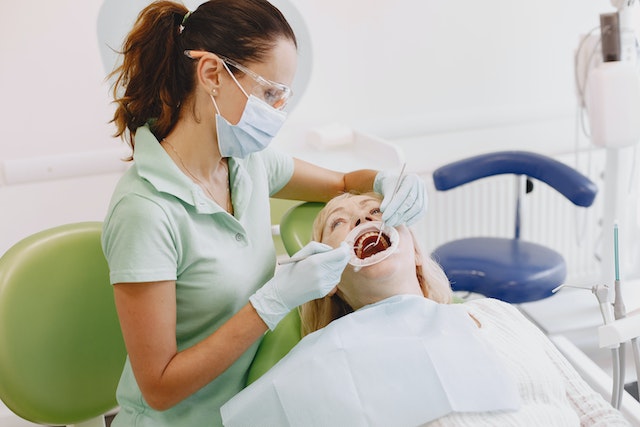Having straight teeth is not just about appearance; they are easier to clean and maintain, leading to better oral health. They also reduce the risk of tooth decay, gum disease, and jaw pain. Furthermore, straight teeth can improve speech and self-esteem, increasing confidence.
While various factors can cause crooked teeth, the good news is that they can be treated through various orthodontic methods, including traditional braces, Invisalign, clear aligners, and retainers. However, it is important to choose a reputable facility to get the best result. Did you know Greenville, SC, has many dental clinics specializing in orthodontic treatments? This makes it an ideal location for individuals seeking treatment for crooked teeth.
This blog will discuss the causes, consequences, and treatment options for crooked teeth, as well as the factors to consider when choosing the right treatment center.
How to Find the Right Clinic?
When selecting a treatment option, it is important to consider factors such as the severity of misalignment, budget, and personal preferences. Moreover, you should pick a clinic near you as it is convenient and saves time and travel expenses.
Invisalign, for instance, is a popular option that utilizes clear aligners to straighten teeth gradually. Choosing a treatment facility that is conveniently located and offers the latest orthodontic treatments can greatly enhance the overall treatment experience. As an example, if you are living in South Carolina, find a local Invisalign Greenville, SC clinic so you get better follow-up care and monitoring of your treatment progress. Palmetto Family Orthodontics is a highly recommended treatment facility that offers a range of orthodontic treatments, including Invisalign.
Causes of Crooked Teeth:
Genetics:
One of the primary causes of crooked teeth is genetics. If one or both parents have crooked teeth, there is a high likelihood that their children will also have the same issue. Genetics can impact the shape and size of the jaw, leading to crowded or misaligned teeth.
Thumb Sucking:
Thumb sucking is a common habit among children and can cause permanent damage to the teeth and jaws if continued past a certain age. The constant pressure applied to the front teeth can cause them to become crooked or misaligned.
Dental Development Issues:
Dental development issues can also lead to crooked teeth. This can include the late loss of baby teeth, crowding, and improper jaw growth. These issues can cause the permanent teeth to come in crooked or misaligned.
Poor Oral Hygiene:
Poor oral hygiene can lead to gum disease and tooth decay, which can cause the teeth to become loose and shift out of place, leading to crooked teeth.
Trauma:
Trauma to the mouth, such as a blow to the face or jaw, can cause teeth to become misaligned or crooked. This can happen immediately after the injury or over time as the jaw and teeth heal.
Tooth Crowding:
Tooth crowding occurs when there is not enough room in the jaw for all of the teeth. This can cause the teeth to become crooked or misaligned as they try to fit into the available space.
Consequences of Crooked Teeth:
Crooked teeth can lead to several oral health problems, including tooth decay, gum disease, and jaw pain. These issues can be difficult to treat and can negatively impact overall oral health.
Other common consequences of crooked teeth include:
- Low self-esteem and a lack of confidence. This can impact social interactions and limit opportunities in life.
- Speech Impediments. This can lead to communication difficulties and decreased confidence in social situations.
- Difficulty in Cleaning Teeth. It can lead to an increased risk of tooth decay and gum disease, which can further contribute to oral health problems.
Diagnosis and Treatment Options:
When seeking treatment for crooked teeth, it is important to choose the right orthodontic method that best suits your needs. However, the first step in treating crooked teeth is to have an orthodontic evaluation. This will assess the severity of the issue and recommend the best treatment option.
There are various options available, these include:
1. Traditional Braces:
Traditional braces are a popular treatment option for crooked teeth. They use metal brackets and wires to apply pressure to the teeth, gradually moving them into the correct position.
2. Invisalign:
Invisalign provides the perfect solution for those wishing to straighten their teeth without having to wear traditional braces. Using a series of custom-crafted, clear plastic trays, Invisalign can gently and effectively move your teeth into the correct position over time. These aligners are virtually undetectable – you won’t even know they’re there! Plus, when it comes time for meals or brushing, simply remove them and put them back on afterwards.
3. Retainers:
Retainers are used after orthodontic treatment to maintain the corrected position of the teeth. They can be removable or fixed and are typically worn at night.
4. Surgery:
In some cases, surgery may be necessary to correct severe cases of crooked teeth. This can involve repositioning the jaw or removing some teeth to create more space.
Each of these treatment options comes with its pros and cons. Therefore, it is recommended to consult with a qualified orthodontist who can recommend the best option for you.
Can You Prevent Crooked Teeth?
The answer is yes. Taking preventive measures can help to keep your teeth straight. Here are some ways:
Early Orthodontic Intervention:
Early orthodontic intervention can prevent or minimize the severity of crooked teeth. By addressing dental development issues early on, orthodontists can help guide the growth and development of the jaws and teeth, reducing the risk of crooked teeth.
Good Oral Hygiene:
Practicing good oral hygiene, including brushing and flossing regularly, can help prevent the development of gum disease and tooth decay, reducing the risk of crooked teeth.
Avoiding Harmful Habits:
Avoiding harmful habits such as thumb sucking and using a pacifier past a certain age can help prevent the development of crooked teeth.
Protecting the Mouth from Injury:
Wearing a mouthguard while participating in contact sports can help protect the mouth and teeth from injury, reducing the risk of crooked teeth.
Regular Dental Visits:
Regular dental visits can help detect and address dental development issues early on, reducing the risk of crooked teeth.
Conclusion:
Crooked teeth can have a significant impact on oral health and overall well-being. With early intervention, good oral hygiene, and the right treatment, it is possible to correct crooked teeth and maintain a healthy, confident smile. Schedule a consultation today to learn more about your options for straightening your teeth.










